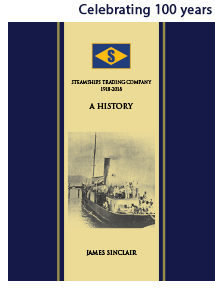Company History
The Steamships story began in the early years of the 20th century in what was then one of the least known parts of the world. Retired sea captain, Algernon Sydney Fitch, founded the business to run salvage operations in Australia. In 1919 he sailed the company’s first ship, the SS Queenscliffe, to Port Moresby to trade along the Papuan coast. In 1924 the public company was formed and the Steamships story had well and truly begun.
At each stage of the economic development of the largest nation and economy in the South Pacific, Steamships has fostered businesses and industries that have helped build PNG. The Group has boosted local economies through businesses initially established in Port Moresby, the gulf and western reaches of the former territory of Papua and later in New Guinea and the Highlands. Steamships' coastal shipping and stevedoring services supported the PNG economy as it started to develop and explore its rich and diverse endowment of natural resources, including plantation crops and mining. In response to new opportunities, Steamships diversified into hotels, manufacturing, distribution and other services.
Steamships Trading Company has a long tradition of investing in Papua New Guinea’s growth, development and progress. Its transition from pioneer coastal trader to a diversified leader in shipping, transport, property, manufacturing, hotels and information technology has been integral to, and part of, Papua New Guinea’s development. More recently that development has accelerated so that Steamships is triple the size it was ten years ago and PNG has become a modern and formative leader within the Asia Pacific region.
An Official History
During its 100 years of existence, Steamships Trading Company has become a Papua New Guinean icon. From its humble beginnings in 1918 as a one-vessel trading operation to its present position as one of the largest private employers in the country, Steamships' history has tracked that of Papua New Guinea itself, and that of its peoples.
In this book the Company's history has for the first time been researched and recorded. The author, James Sinclair, was himself a long-time resident of PNG. He has done meticulous research and conducted many interviews. Perhaps uniquely in a history of this magnitude, he has been able to speak with all but three of the Managing Directors who have steered the course of the Company from its beginnings, and has also drawn on the memories and records of many other people, for whom Steamships was an integral part of their lives. All this makes this history a very personal document, as it charts the struggles and achievements of many people, Papua New Guinean and expatriate, who played their parts in the building of this great company.
I believe that this history highlights what has made Steamships successful. Its founder, Captain Fitch, was a dynamic, dedicated and progressive man, not averse to taking risks and standing up for what he felt was the right course. His approach has been followed by successive management teams over the years, with results that speak for themselves.
When I joined Steamships in 1956 it was the junior brother in the triumvirate of Burns Philip, W.R. Carpenter and Steamships. Burns Philip has all but disappeared and is not but a fading memory in PNG. Carpenter's is still there, but not as a major presence in the perception of the public. Steamships is now the premier trading company of PNG.
I was directly involved with Steamships, as employee, Director and Chairman, for 47 years between 1956 and 2003. This history brings back a wealth of memories for me, as it will for a great many others. It also stands as a proud guide for those who will come after, ensuring that the story of the Company, and the lessons of the past, will be there to help shape the future.
James Sinclair has done an excellent job in bringing together the tangled threads of this complex story, and producing a fascinating and very educational book.
Don Harvey
Chairman 1976-1986
